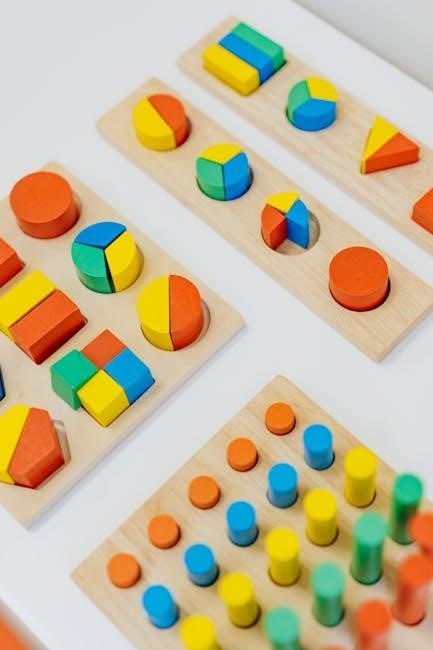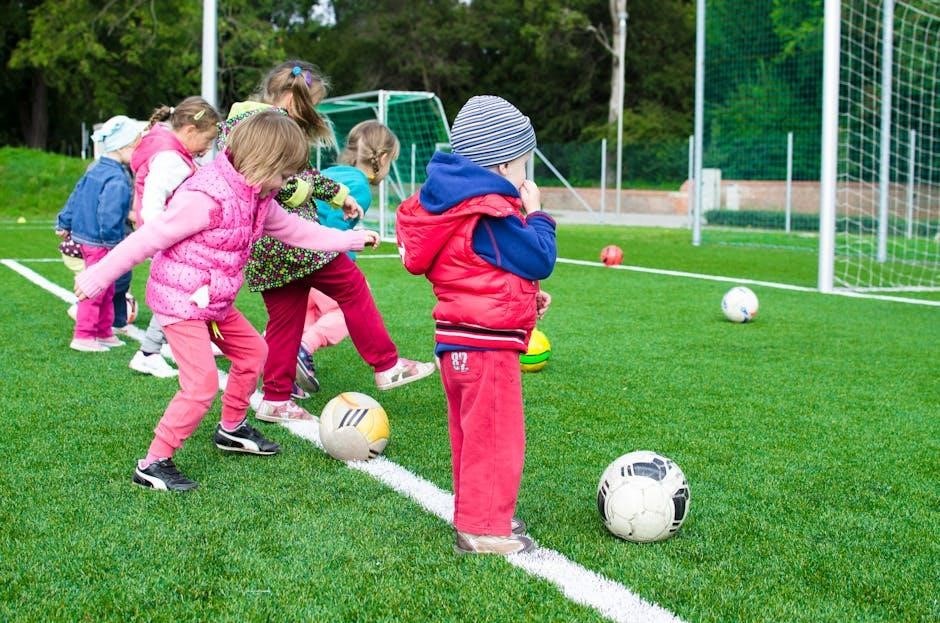Comprehension for Kindergarten PDF: A Comprehensive Guide
This guide provides insights into teaching reading comprehension to kindergartners using PDF resources․ It includes engaging activities, interactive strategies, and tips for effective skill development in young learners․
Key topics: understanding narratives, critical thinking, and the role of visual aids in early education․
Comprehension in kindergarten lays the foundation for understanding texts and fostering a love for reading․ It involves engaging young learners in activities that promote critical thinking and storytelling․ By introducing simple narratives, teachers help children connect words with meanings and pictures․ This active process encourages early readers to interpret stories, identify main ideas, and make connections to their experiences․ Effective strategies include using visual aids, interactive discussions, and hands-on activities to make learning fun and accessible․ Early comprehension skills are crucial for future academic success and confidence in literacy․
Importance of Early Reading Comprehension Skills
Importance of Early Reading Comprehension Skills
Developing early reading comprehension skills is crucial for young learners, as it builds a strong foundation for future academic success․ These skills enhance critical thinking, vocabulary expansion, and the ability to interpret texts․ Early comprehension fosters a deeper understanding of stories, helping children make connections between words and meanings․ It also boosts confidence in reading and communication․ Introducing these skills in kindergarten prepares students for more complex literacy tasks later․ By nurturing comprehension early, educators empower children with essential tools for lifelong learning and a love for reading․
Key Components of Reading Comprehension
Reading comprehension involves several key components that work together to help young learners understand texts․ These include decoding, vocabulary, fluency, and the ability to make connections between the text and prior knowledge; Critical thinking plays a vital role, as children learn to interpret meanings, identify main ideas, and recognize supporting details․ Visual aids, such as pictures and charts, enhance understanding by providing context․ Additionally, summarizing and predicting outcomes are essential skills that reinforce comprehension․ These components are interconnected, ensuring that kindergarten students develop a holistic understanding of stories and information, laying the groundwork for advanced literacy skills․

Effective Strategies for Teaching Comprehension
Engage young learners with reading aloud, visual aids, and interactive discussions․ Reciprocal teaching methods, like summarizing and questioning, foster active participation and deeper understanding of texts․
Reading Aloud to Kindergarten Students
Reading Aloud to Kindergarten Students
Reading aloud is a powerful strategy to enhance comprehension in kindergartners․ It engages students, builds vocabulary, and introduces them to complex sentence structures․ By pausing to discuss the text, teachers can encourage critical thinking and clarify misunderstandings․ Visual aids, such as illustrations, further support understanding․ This method also fosters a love for reading and exposes young learners to diverse themes and genres․ Regular read-aloud sessions create opportunities for students to connect with stories emotionally and intellectually, laying a strong foundation for future reading skills․
Key benefits: improved comprehension, vocabulary expansion, and enhanced engagement․
Using Visual Aids for Better Understanding
Using Visual Aids for Better Understanding
Visual aids are invaluable for enhancing comprehension in kindergartners․ Images, charts, and videos help students connect text to real-world concepts, making stories more relatable․ Pictures in PDFs or digital tools can illustrate complex ideas, while diagrams break down sequences or relationships․ This approach supports visual learners and reinforces understanding․ By pairing text with visuals, teachers can guide students to identify key details and themes․ Visual aids also capture attention, fostering engagement and retention․ They are particularly effective for young learners, as they simplify abstract concepts and create a bridge between words and meanings, fostering a deeper connection to the material․
Encouraging Interactive Discussions
Encouraging Interactive Discussions
Interactive discussions are a powerful tool for fostering reading comprehension in kindergarten․ By engaging students in conversations about stories, teachers help them articulate thoughts, clarify doubts, and connect ideas․ Open-ended questions encourage critical thinking and participation․ Think-pair-share activities allow students to express ideas in small groups before sharing with the class․ Such discussions build confidence, enhance understanding, and promote collaboration․ Teachers should guide conversations to ensure relevance and depth, helping students draw meaningful insights from texts․ Interactive discussions make learning dynamic and inclusive, fostering a love for reading and dialogue from an early age․
Implementing Reciprocal Teaching Methods
Implementing Reciprocal Teaching Methods
Reciprocal teaching is a collaborative strategy that enhances reading comprehension by engaging students in structured discussions․ Teachers model techniques like summarizing, questioning, clarifying, and predicting, then guide students as they practice these skills․ This method fosters active participation, encouraging students to think deeply about texts․ By taking turns leading discussions, kindergartners build confidence and develop critical thinking․ Reciprocal teaching also promotes peer learning and fosters a supportive environment where students feel comfortable sharing ideas․ Regular use of this approach helps young learners grasp stories more effectively and prepares them for independent reading and comprehension tasks․

Age-Appropriate Activities for Comprehension Development
Engage kindergartners with hands-on crafts, interactive storytime, and open-ended questions to foster comprehension skills․ These activities, supported by technology, create a dynamic learning experience tailored to young learners․
Storytime Sessions with Open-Ended Questions
Storytime Sessions with Open-Ended Questions
Storytime sessions are a cornerstone of early comprehension development․ By reading engaging stories aloud, teachers can foster a love for narratives while encouraging critical thinking․ Open-ended questions, such as “What do you think will happen next?” or “Why do you believe the character acted that way?” prompt students to think deeply and make connections․ These discussions not only enhance understanding but also build vocabulary and creativity․ Visual aids, like illustrations, further support comprehension, making stories more accessible and relatable for kindergartners․ Regular storytime with interactive questioning helps young learners develop the skills to interpret and reflect on texts effectively․
Hands-On Crafts to Reinforce Story Themes
Hands-on crafts are an engaging way to deepen kindergartners’ understanding of story themes․ By creating art related to the narrative, children connect visually and tactilely with the content, enhancing retention․ Activities like puppet-making, scene dioramas, or character drawings encourage students to reflect on plot, characters, and settings․ These projects also foster creativity and fine motor skills while reinforcing comprehension․ Discussing their creations in small groups further promotes critical thinking and collaboration, making learning both fun and meaningful․ Such interactive approaches ensure that young learners internalize story elements, supporting their overall comprehension development in an enjoyable and immersive way․

Utilizing Technology for Interactive Learning
Technology enhances kindergarten comprehension through interactive and engaging tools․ Educational apps and digital games incorporate stories, quizzes, and puzzles to make learning fun․ Interactive e-books with narration and animations capture young learners’ attention, aiding retention․ Digital platforms also offer collaborative features, allowing students to share thoughts and ideas․ Teachers can use technology to track progress and adapt lessons to individual needs; By integrating tech, classrooms create a dynamic environment where children explore stories, develop critical thinking, and build foundational skills in an innovative way, fostering a love for learning from an early age․

Assessment and Progress Tracking
Assessment in kindergarten involves observing students during activities and using tools like worksheets to monitor comprehension progress․ Teachers track development through formative assessments and participation in class discussions․
Key tools: PDF resources, quizzes, and interactive exercises to evaluate understanding and guide instruction effectively․
Formative Assessments in Kindergarten
Formative Assessments in Kindergarten
Formative assessments in kindergarten are informal, ongoing evaluations to monitor progress in reading comprehension․ Teachers use observations, class discussions, and simple quizzes to gauge understanding․ These assessments help identify learning gaps and strengths, allowing for tailored instruction․ Tools like PDF worksheets and interactive activities provide valuable insights into a child’s ability to interpret stories and answer questions․ By regularly tracking progress, educators can adjust teaching strategies to meet individual needs, ensuring young learners build a strong foundation in comprehension skills․ This approach supports personalized learning and fosters a love for reading in kindergarten students․
Using Worksheets and PDF Resources
Using Worksheets and PDF Resources
Worksheets and PDF resources are essential tools for teaching reading comprehension in kindergarten․ These materials provide engaging activities that reinforce comprehension skills, such as matching games, sequencing exercises, and simple question-and-answer prompts․ PDFs often include colorful illustrations and age-appropriate content, making them appealing to young learners․ They also offer a structured way to practice understanding stories, identifying main ideas, and recalling details․ Many PDF resources include open-ended questions to encourage critical thinking and creativity․ Teachers can easily print and distribute these materials, making them a convenient and effective way to support early literacy development and track student progress․
Observing Student Participation in Class
Observing student participation in class is a valuable way to assess comprehension skills in kindergartners․ By watching how children engage during discussions and activities, teachers can identify strengths and areas for improvement․ This method allows for real-time insights into how students process information and apply understanding․ It also helps in gauging their ability to articulate thoughts and connect ideas․ Observations can reveal non-verbal cues, such as attentiveness or confusion, providing teachers with opportunities to offer personalized support․ This approach complements formal assessments and fosters a more inclusive and responsive learning environment, ensuring each child’s needs are met effectively․

Resources and Materials for Teachers
Teachers can utilize a variety of resources, including kindergarten-specific PDF worksheets, educational apps, and library books, to support comprehension development․ These tools provide engaging and structured activities to enhance learning outcomes for young students․
Recommended PDF Worksheets for Kindergarten
Recommended PDF Worksheets for Kindergarten
Kindergarten PDF worksheets are designed to promote early reading comprehension through engaging activities․ These resources often include colorful illustrations, simple sentences, and tasks like matching games or sequencing․ They focus on basic story understanding, vocabulary building, and critical thinking․ Many worksheets incorporate visual aids to help young learners connect text with images․ Teachers can find curriculum-aligned PDFs that cater to different skill levels, ensuring a gradual progression in comprehension abilities․ These materials are ideal for classroom use or homework, providing structure and fun for developing reading skills in a supportive learning environment;
Educational Apps for Reading Comprehension
Educational Apps for Reading Comprehension
Educational apps are powerful tools for fostering reading comprehension in kindergartners․ Apps like ABCmouse and Endless Reading offer interactive stories, quizzes, and games that make learning fun․ They incorporate colorful animations, voice narration, and touch-screen activities to engage young learners․ Many apps adapt to a child’s skill level, providing personalized learning experiences․ Features such as progress tracking and rewards motivate children to improve their comprehension skills․ These apps are ideal for both classroom and home use, offering a modern, tech-driven approach to early literacy development․ They complement PDF worksheets by adding interactivity and variety to learning routines․
Library Books and Digital Stories
Library Books and Digital Stories
Library books and digital stories are essential tools for developing comprehension skills in kindergartners․ Classic children’s literature, such as The Little White Horse and Stig of the Dump, offers rich narratives that spark imagination and critical thinking․ Digital stories, often accompanied by animations and voiceover, engage young learners and make complex texts accessible․ Many platforms provide interactive features like read-aloud options and comprehension quizzes․ These resources complement PDF worksheets by offering a dynamic way to explore stories․ They also encourage a love for reading while helping children connect with diverse themes and characters, fostering both literacy and emotional intelligence․

The Role of Parents in Comprehension Development
Parents play a vital role in fostering early comprehension skills through consistent home reading practices and open discussions about stories, helping children build a strong foundation for literacy․
Engaging in Home Reading Practices
Engaging in Home Reading Practices
Home reading practices are essential for developing kindergarten comprehension skills․ Parents can create a cozy reading environment, encouraging daily reading sessions with their child․ Using pictures and simple texts, parents can guide children in understanding narratives․ Asking open-ended questions about the story, such as “What do you think will happen next?” or “Why do you think the character did that?” fosters critical thinking․ Discussing the main idea and key details after reading helps reinforce comprehension․ Consistent engagement in these practices builds vocabulary, fluency, and a lifelong love for reading, laying a strong foundation for future academic success․
Creating a Supportive Learning Environment
Creating a Supportive Learning Environment
Creating a supportive learning environment at home is crucial for fostering kindergarten comprehension skills․ Organize a dedicated space for learning, incorporating visual aids like charts, pictures, and word walls to make concepts tangible․ Use themed corners for reading, crafts, and STEM activities to spark curiosity․ Label objects and encourage interactive play to build vocabulary․ Integrate technology with educational apps or digital stories to engage young learners․ Positive reinforcement and patience are key․ By designing a structured yet flexible environment, parents can nurture a love for learning, ensuring their child feels comfortable exploring and developing essential comprehension abilities․

Technology Integration in Comprehension
Technology integration enhances kindergarten comprehension through interactive PDFs, educational apps, and digital stories․ These tools provide engaging, visually-rich experiences that make learning fun and accessible for young students․
Key tools: AI-driven platforms, interactive e-books, and audio-visual resources that cater to diverse learning styles․
AI and Prompt Engineering in Education
AI and Prompt Engineering in Education
AI and prompt engineering are revolutionizing education by creating personalized learning experiences․ These technologies help generate tailored reading materials and interactive exercises, making comprehension engaging for kindergartners․ AI-driven tools can analyze a child’s reading level and adapt content accordingly, ensuring optimal learning outcomes․ Prompt engineering allows teachers to design specific tasks that foster critical thinking and language skills․ For example, AI can create interactive stories that adjust complexity based on student responses․ This approach not only enhances comprehension but also makes learning fun and dynamic, preparing young learners for future academic success in a tech-driven world․
Digital Tools for Interactive Learning
Digital tools are transforming how kindergartners engage with reading comprehension․ Interactive e-books, educational apps, and online platforms offer dynamic content that combines text with visuals and sounds․ These tools often include quizzes, games, and activities that make learning fun․ For example, apps like Khan Academy Kids or Epic! provide tailored reading experiences with interactive elements․ Digital tools also allow teachers to track progress and adapt lessons to individual needs․ By integrating technology, young learners can develop comprehension skills in an engaging and modern way, preparing them for a digitally driven future while fostering a love for reading and learning․

Challenges in Teaching Comprehension
Teaching comprehension to kindergartners presents challenges, including diverse learning abilities and maintaining engagement․ Tailoring lessons to varied skill levels while keeping young minds focused can be particularly demanding․
Addressing Diverse Learning Needs
Addressing Diverse Learning Needs
In kindergarten, diverse learning needs require tailored approaches․ Teachers must adapt strategies to accommodate varying developmental stages and abilities․ Using visual aids, interactive tools, and hands-on activities can help cater to different learning styles․ Incorporating technology, such as educational apps, can also provide personalized learning experiences․ Assessing individual progress through formative assessments and observations ensures that each child receives targeted support․ Additionally, reciprocal teaching methods and think-aloud procedures can foster engagement and understanding, helping all students grasp comprehension skills regardless of their learning pace or style․
Managing Classroom Engagement
Managing Classroom Engagement
Engaging kindergartners in comprehension activities requires dynamic and interactive strategies․ Teachers can foster focus by incorporating movement, music, and hands-on tasks that align with reading content․ Using technology, such as educational apps, can captivate young learners and maintain their interest․ Positive reinforcement and encouragement play a crucial role in building confidence and participation․ Modeling active listening and thinking aloud demonstrates engagement, inspiring students to emulate these behaviors․ Rotating roles during group discussions and activities ensures everyone feels involved, creating an inclusive and motivating learning environment that supports comprehension development․
This comprehensive guide emphasizes the importance of early comprehension skills, offering practical strategies and resources to support young learners in developing a strong reading foundation effectively․
Developing reading comprehension in kindergartners is foundational for future academic success․ Strategies like reading aloud, using visual aids, and encouraging discussions foster engagement․ Interactive tools and hands-on activities reinforce understanding, while formative assessments and PDF resources track progress․ Parents play a crucial role by creating supportive environments and practicing home reading․ Technology, including educational apps, enhances learning experiences․ Addressing diverse needs and maintaining classroom engagement are key challenges․ By integrating these methods, educators can effectively nurture early comprehension skills, setting students up for lifelong learning․
Final Thoughts on Early Comprehension Development
Early comprehension development lays the foundation for lifelong learning and academic success․ By incorporating strategies like reading aloud, visual aids, and interactive discussions, educators foster a deep understanding of texts․ The integration of technology, such as AI-driven tools, offers innovative ways to engage young learners․ Parents and teachers must collaborate to create supportive environments that encourage curiosity and critical thinking․ While challenges like diverse learning needs exist, tailored approaches ensure inclusivity․ Investing in early comprehension skills empowers kindergartners to thrive, preparing them for future challenges and fostering a love for learning that extends beyond the classroom․

Future Trends in Kindergarten Comprehension
Future trends emphasize personalized learning through AI-driven tools and interactive simulations, enhancing engagement and tailoring instruction to individual needs, fostering deeper understanding and creativity in young learners․
Innovations in Teaching Methods
Innovations in Teaching Methods
Innovative teaching methods for kindergarten comprehension include AI-driven tools, interactive simulations, and personalized learning platforms․ These approaches create immersive, engaging experiences, making learning fun and effective․ AI adapts content to each child’s pace, while interactive simulations bring stories to life, enhancing visual and kinesthetic learning․ Teachers can also use real-time feedback tools to track progress and tailor instruction․ Gamification elements, such as rewards and challenges, motivate young learners to explore texts deeply․ These methods foster critical thinking, creativity, and a love for reading, preparing kindergartners for future academic success in a dynamic, ever-evolving educational landscape․
The Role of AI in Future Education
The Role of AI in Future Education
AI is revolutionizing early education by offering personalized learning experiences for kindergartners․ Tools like adaptive reading software and interactive simulations cater to individual learning paces, enhancing comprehension skills․ AI-driven platforms analyze progress, providing real-time feedback to teachers and parents․ Prompt engineering enables tailored prompts to guide young learners, fostering critical thinking․ Additionally, AI-powered apps create engaging, gamified activities that make reading fun․ These innovations not only support teachers but also ensure equitable access to high-quality education․ By integrating AI thoughtfully, educators can nurture a love for learning, preparing children for future academic challenges in a tech-driven world․